Does Geo Heating Need a Continued Source of Water
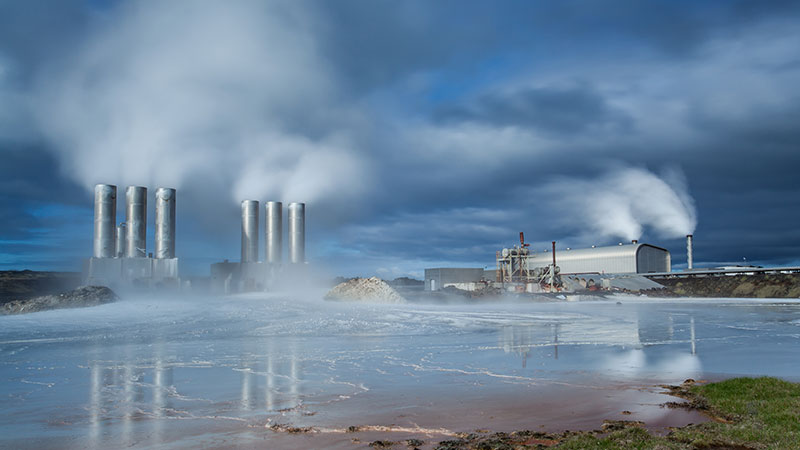
With an increased emphasis on reducing energy emissions and carbon footprint taking center stage, geothermal heating and cooling systems have become popular with homeowners across the US. Geothermal systems have been in place since the 1940s, starting by providing basic water heating. Over time, incorporating new technologies and advances in air handling systems has made geothermal systems suitable as a commercially viable alternative to more conventional HVAC systems.
Geothermal heating and cooling systems, also called Ground Source Heat Pumps (GSHP), provide heating and cooling by exchanging heat with the ground. These systems take advantage of the fact that the grounds' temperature remains relatively constant throughout the year, ranging from 45o to 75o F. Depending upon the season, the ground can serve as a heat source or a heat sink.
The major benefit of geothermal heat pumps is that they use 25% to 50% less electricity than other heating or cooling systems. Also, even though the initial installation costs can be high, the relatively short payback period of 6-7 years makes up for the upfront investment. After this period, it's low maintenance, energy-efficient HVAC system for your home.
All geothermal cooling and heating systems have a few common components. These include a mechanism for transferring the heat exchange fluid to the ground and back, a heat pump to move the fluid, and a distribution system.
Let's take a glance at each of these sub-systems and their roles.
Geothermal Loop Systems
All kinds of geothermal systems employ a mesh of interconnected pipes used as heat exchangers placed underground. In the winters, when it is cold in the air but warm in the ground, refrigerant within these coils absorbs the heat from the ground and transfers it into the building. The same process is reversed for the summers when the heat is absorbed from the building and rejected into the ground.
This loop system connects to the geothermal heat pump. It includes the compressor, pump, and an optional air handler unit if the system heats the air. This air is then circulated throughout the house using a system of ducts and vents.
Geothermal systems are categorized according to the design of the heat exchangers. They can be closed loops, open loops, vertical, horizontal, pond loops, or slinky loops. Closed-loop systems recirculate the already present refrigerant within the system. On the other hand, open-loop systems constantly refresh the refrigerant, using a freshwater lake or underground aquifer since the refrigerant is mostly water in this case.
Closed-Loop Geothermal Systems
Closed-loop systems are the common type being used for geothermal systems. Water, mixed with anti-freeze or another suitable refrigerant, is used within the heat exchanger coils to serve as the heat exchange medium. There is no need to replenish the fluid in the system continuously. This system can be further divided according to the orientation of the heat exchanger loops within the ground.
Vertical Loops
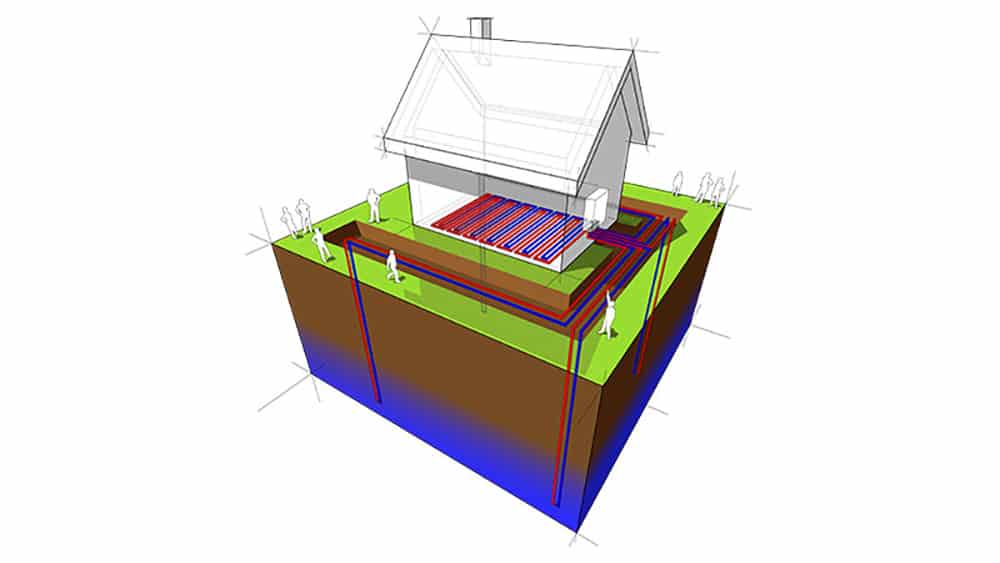
As is evident, the heat exchangers in this type are vertically oriented. Holes are drilled up to 400 feet deep, and U-tubes are placed within them. Multiple U-tubes in different holes are then connected to form a closed network, which is then connected with the pump and compressor (if there is one).
The borehole is then filled with grout to provide better thermal conductivity between the U-tubes and ground. The number of boreholes, their spacing, depth, and volume of fluid in U-tubes all depends on the soil characteristics, heating and cooling needs of the home, temperature variations.
An advantage of this arrangement is that it can be placed within a small surface area compared to horizontal loops. This makes it ideal for small homeowners or schools within built-up areas, where real estate can often be a premium. But preventive measures need to be undertaken so that the boreholes are strong enough not to collapse. Moreover, the drilled subsoil should still be able to hold the buildings within the vicinity.
Horizontal Loops
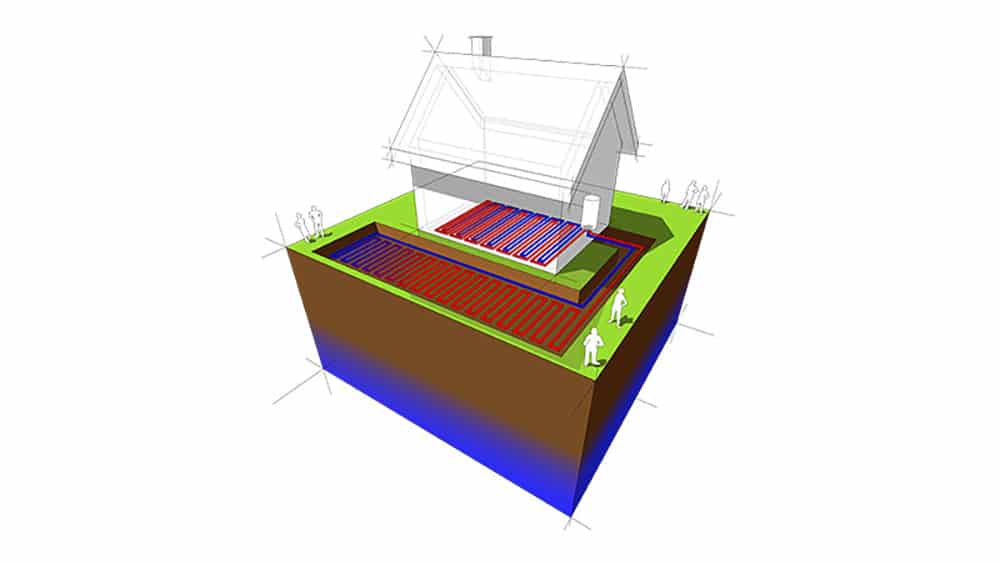
A horizontal loops system composes of pipes that are placed in a horizontal orientation along the ground. A shallow and long trench, deeper than the frost line, is dug, and U-tubes are placed within them. Generally, the depth is anywhere from 1 to 3 meters. The length can be up to 400 feet, depending on the specific requirements.
Depth can have a profound effect on the heating and cooling characteristics of a horizontal loop system. If too shallow, the loops can absorb heat from the sun during the change from winter to summer, when the ground is still comparatively cold. This increases the heating capacity of the system. But an adverse effect is that during the winter months, the loops will be cooled down at a greater rate due to their proximity to the surface.
This problem can be eliminated by increasing the depth of the loops, with the increased installation cost being offset by the saving in energy. Another solution is to use a thermally non-conductive top layer above the loops. This prevents the loops from being affected by the topsoil or atmospheric changes in temperature.
Horizontal loop systems are more suited to areas with a large amount of ground available to be dug up, such as large farmhouses, countryside estates, etc.
Slinky Loops

Much like horizontal loops, slinky loops are used where horizontal loops have to be used, but there is not enough space available. Coil-like pipes are placed in shallow trenches similar to horizontal loops. These loops overlap with each other when placed on the bottom of the trench. This provides the same amount of distance for the fluid to pass through within the pipes but with a shortened coverage length of the whole system.
Pond Loops
These systems are used where there is a suitable body of water nearby. The loops can be submerged underneath the water or placed on the bed of the waterbody. Such a system has no digging or drilling costs associated with it, and in the case of a fault or leakage, it provides for easy extraction of the loop system. The water body should be sufficiently deep so that the surface effects of temperature do not translate within the loops.
Open Loop Geothermal Systems

Open-loop systems are the simplest of all forms of geothermal heating systems. An open-ended pipe is used to draw water from an underground aquifer, hot spring, or another suitable water source. This water is then passed through the heat exchangers within the heat pump. The used-up water is then discharged within the same water source, at a suitable distance from the water intake. Open-loop systems do have a few challenges, however.
Great care must be taken to ensure that the input water is sufficiently clean and has a suitable mineral composition not to damage the heat pump or heat exchangers. Dissolved chemicals or solids within the water can react with the heat exchangers' material and serve as a corrosion accelerator. Limescale can form on the interior of the pipes, thus reducing water flow.
Moreover, environmental regulations in some places require the output water to be treated before being discharged. Even stricter regulations can completely ban the discharge of water, thus necessitating closed-loop systems.
Geothermal Heat Pumps
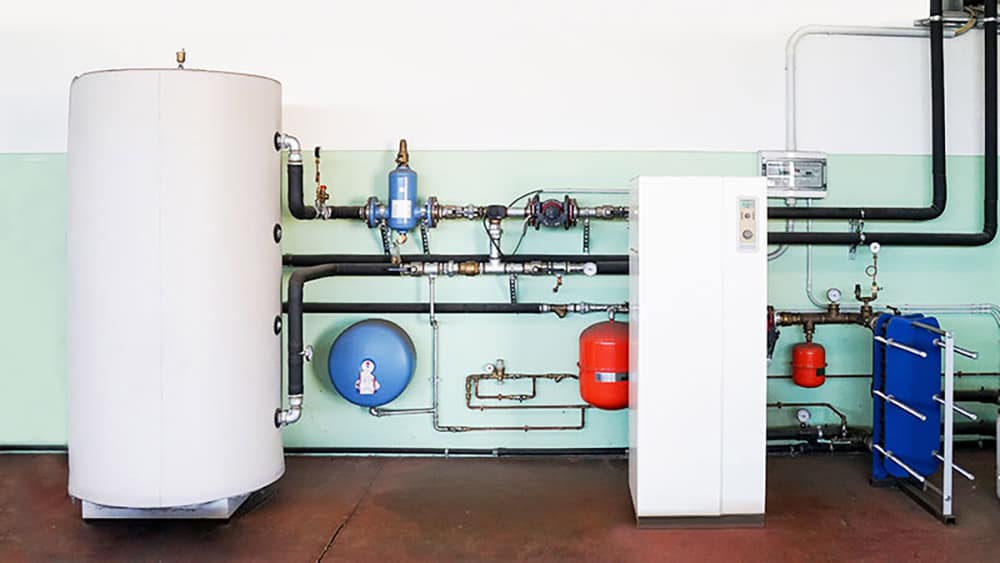
Almost every type of geothermal system has a heat pump with it. It is usually installed in a cabinet, somewhere out of sight. A geothermal heat pump consists of a compressor, heat exchanger, and other allied control systems. If the heating and cooling system uses air to condition the interior spaces, an air handling unit is also part of the package.
Heat pumps work by exchanging heat between the refrigerant (usually water) in the ground loops and the medium within the ductwork. During the winter months, the water absorbs heat from the ground and travels to the heat exchanger in the heat pump. The refrigerant is then compressed, raising its temperature and turning it into gas. The heat within the refrigerant is then extracted using heat exchangers and passed through a system of ducts or pipes throughout the home. The last step is usually done with air handling units if the air is used to distribute the heat.
This process is reversed in the summer months. With geothermal cooling, the refrigerant absorbs heat from the indoors and rejects it to the ground through the underground loops.
Geothermal Distribution System
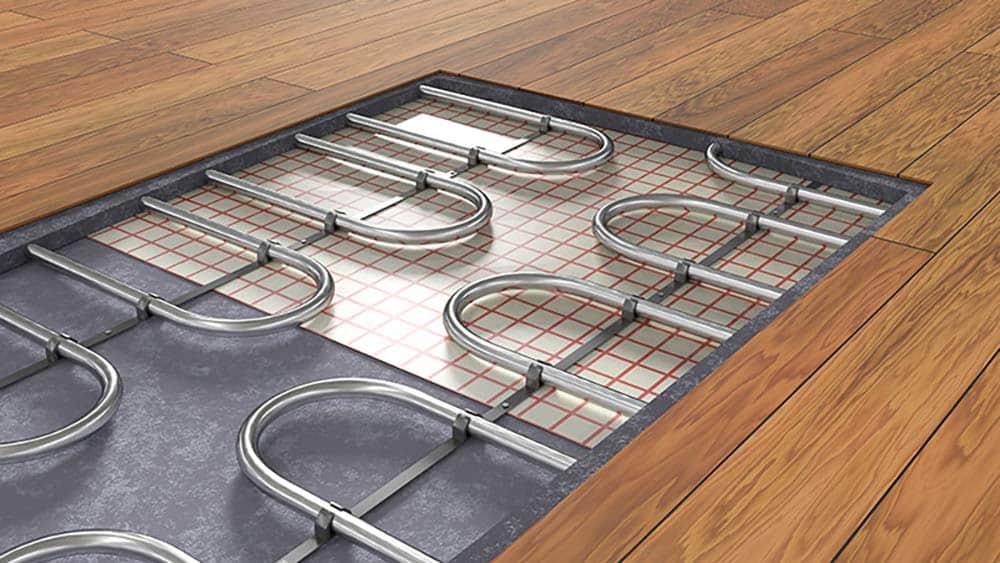
As with ducted air conditioning systems, geothermal systems also employ a system of ductworks. This makes geothermal systems especially suitable for renovation projects in homes with ductwork already installed. The existing ducts can then be utilized for this purpose.
This holds for systems that transfer heat throughout the building using air, called liquid-to-air systems. Air handling units, which are big fans, move large volumes of air across ducts. But in some systems, water is directly pumped throughout homes using pipes embedded in the home's base structure or through radiator space heaters – such an arrangement is called water-to-water.
Water-to-water systems can also be used as water heaters for domestic use. A geothermal heat pump can keep the running water at a cozy 120o F, which is less than the required 150-200o F achieved through boilers. But pre-heating the water through a geothermal system results in energy savings with the boiler.
Water-to-water arrangements are a popular option for water distribution systems for heating and cooling. Loops are embedded underneath the flooring or within the walls. These loops remain out of sight and do not make any noise while still providing heating and cooling. Another choice is to use baseboard heating systems in conjunction with geothermal systems. But be careful with this option, and consult a professional for proper sizing of your home and the heating requirements.
Installation Costs for Geothermal Heating and Cooling
Geothermal systems present a higher upfront initial investment than contemporary home heating and cooling systems though these costs are gradually decreasing. With a growth rate of around 12% annually in the geothermal system market, more and more manufacturers drive up the competition and bring prices down.
On average, home geothermal systems can cost anywhere from $10,000 to $30,000. The exact amount depends upon the soil characteristics, area to be dug up, whether it is a vertical loop or horizontal loop system, conditioning area within the home, prior ductwork, and installation quality. Higher-end versions can cost even more than this.
In addition, the choice between water-to-air and water-to-water can also have a bearing on the cost. Water-to-air heat pumps are the more economical choice between the two.
Drilling and digging can amount to more than half of the total cost of installation of a geothermal system. Geothermal heat pump installation for the whole system can also be costly. Geothermal heating and cooling costs average at $2,500 per ton, according to the US Department of Energy.
Advantages of Geothermal Heating and Cooling Systems
The advantages offered by geothermal systems are numerous. Let's see some of those:
- Energy Efficiency
As far as efficiency is concerned, geothermal heating and cooling systems far outscore conventional air conditioning. The main reason for that is that a geothermal heat pump system is not ejecting heat to a hot outdoor environment, rather transferring it into a cool environment.
As discussed before, a geothermal system can provide energy savings up to a staggering 50%. This can seem like a Godsend in the hot summer months. This is in part due to the high Energy Efficiency Ratios of geothermal systems, reaching as high as 25, as compared to 15 for conventional systems. Geothermal cooling can hence have a major impact on your summer bills.
- Convenience
A geothermal system does not have many parts to be taken care of, like a conventional HVAC system. There are no ducts; there are no dampers or louvers; no fuel needs to be kept in check. You do not have to maintain a furnace in the winters and a heat pump in the summers. The two major components of geothermal systems are the ground loops and the heat pump. The ground loops are installed right at the beginning and seldom need to be taken care of again.
- Reduced Maintenance
The average lifespan of a conventional air conditioner is somewhere around 10-15 years. But this is only after due care and maintenance. If you neglect proper HVAC care, the lifespan can shorten.
A geothermal heating or cooling system, on the other hand, can last anywhere from 20 to 50 years. Minimal maintenance is required. The ground loops do not need to be periodically checked, and the system can keep on running for a long time. This is because a geothermal system is not exposed to harsh elements all year round. A conventional HVAC system is exposed to the wind and temperature variances, along with the harmful pollutants present in the air.
Savings by Geothermal Heating and Cooling System
Enough about the costs, let's talk about the savings! At the moment, geothermal systems installed homes are qualified for a 30% federal tax credit. In addition to this, most states or electric utilities provide rebates or grants to homes using geothermal energy systems. This can also drive down geothermal heat pump costs significantly. To find out if you are eligible for the rebate, head over to the Database for State Incentives for Renewables and Efficiency.
Your electricity utility bills will also take a nosedive. An estimated 42% of home energy use is for heating needs. The use of geothermal systems can reduce this usage by 50%, depending on site specifics. The same is the case with greenhouse emissions.
With an average life of 20-25 years, geothermal heating and cooling systems can result in up to $75,000 in energy savings during their lifetime. The payoff period is much shorter than that, ranging from 5-8 years on average. As you can see, even though the geothermal heating and cooling costs can be high initially, they will pay off in the longer run.
Should You Consider Geothermal Systems?
Absolutely yes. The energy savings and emissions cuts obtained through geothermal systems do make them an attractive proposition. Even if geothermal systems do not provide the complete package, they can be used as supplemental systems.
The final choice depends on your specific situation: If it's a new house or an old one, the heating and cooling capacities required, and much more. Finances also have to be taken into account. Geothermal heat pump costs can look prohibitive. But, as always, with HVAC systems, be sure to consult a seasoned professional before spending your cash!
Source: https://www.cielowigle.com/blog/understanding-geothermal-heating-and-cooling-systems/
0 Response to "Does Geo Heating Need a Continued Source of Water"
Post a Comment